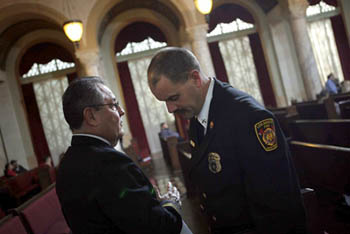Facing a shrinking number of options to close a budget gap that could grow to $600 million in the next fiscal year, the Los Angeles City Council is weighing whether to deactivate 10 rescue ambulances at night.
Council members postponed a decision Tuesday amid confusion about how the proposal would affect response times and after listening to the tearful testimony of a man whose father recently died of a heart attack.

Roderick Garcia, left, assistant chief of the Los Angeles Fire Department's training division, talks with Battalion Chief Patrick Butler, who disagrees with the proposed cuts, saying it would compromise safety. (Photo: Jay L. Clendenin / Los Angeles Times)
Fire officials had reluctantly advanced the cost-saving measure as part of their obligation to help reduce the city's budget gap.
By reassigning 60 firefighters who staff the 10 ambulances with the fewest calls per day -- 3.5 on average -- budget officials said the city could save $3 million over the next few months and $20 million in the next fiscal year.
But a number of council members questioned whether there would be sufficient backup for targeted ambulances in the city's outlying areas.
The stations at risk of losing a basic life support rescue unit during off-peak hours are in Cahuenga Pass, Eagle Rock, Franklin Canyon, Granada Hills, Porter Ranch, South El Sereno, Sunland, Terminal Island, West Hills and Wilmington.
Initially, fire officials told a budget panel led by Councilman Greig Smith that the ambulances could still respond to the overwhelming majority of their emergency calls because most are during the day.
Later, fire officials said the daytime operations actually accounted for about 60% of the calls -- and that the remaining 40% of calls would have to be shifted to nearby stations overnight.
Smith, who has three ambulances slated for reduced hours in or at the border of his district, said that was "not an acceptable rate."
"We're asking the Fire Department to go back and scrub the numbers," he said.
Luis Gonzalez, who lives near Fire Station 16 in El Sereno, warned that shutting down its ambulance at night could take away the community's sense of security. He told council members that firefighters in his area did all they could to save his father, who died of a heart attack in late February.
"It's not going to bring my dad back, but you have to understand the lifeline that the city pays for," Gonzalez said.
Pat McOsker, president of United Firefighters of Los Angeles City Local 112, reminded the council that the city already has fewer basic life support ambulances operating this fiscal year than last.
"When you close these resources, we're going to continue to respond and do everything to save every life that we can, but we're going to get there later," McOsker said.
According to Battalion Chief Patrick Butler, the city has 127 ambulances -- 89 are advanced life-support ambulances staffed by two paramedics who respond to critical emergencies such as heart attacks and 38 are basic life-support units manned by two firefighters trained as emergency medical technicians who handle less serious injuries such as sprained ankles or broken fingers.
Because of this year's budget cuts, Butler said six of the basic life-support units are out of operation daily in varying locations around the city.
Council members have asked city analysts to explore other money-saving options, including reassigning 57 firefighters who aide battalion chiefs at emergency scenes and coordinate firefighter staffing.
City budget officials say the "staff assistant" proposal could save $24 million next year, but Fire Chief Millage Peaks has argued that those aides provide a critical safety net for firefighters on the line.
Though the ambulance proposal will come back for consideration within a few weeks, some council members signaled that they are unlikely to support cuts under any circumstances.
"There's nothing that can more directly affect whether someone lives or dies, among all the services in our entire budget, than ambulance and paramedic services," said Westside Councilman Paul Koretz. "And I honestly think that is the absolute last place that we should be looking at cutting."











